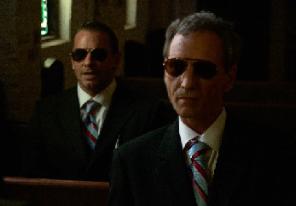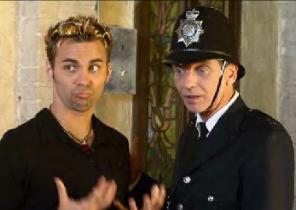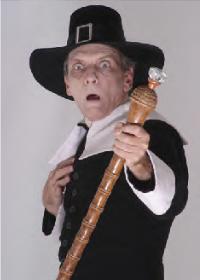|
Find interviews by: | ||
Ted Newsom (Part 2) Go back to Part 1 of this very long interview
“There’s a big, famous mansion in central California built over a period of several decades in the 19th century. The sole heir to the Winchester Rifle fortune, a dotty old lady, was told by her spirit guides that all the souls of all the Indians killed by bullets from Winchester repeating rifles were uneasy, and would come and get her and kill her when she finished building her mansion, since her family fortune was tainted with their blood. Being a sensible soul, she figured out a way around this by never finishing the house. She had contractors, carpenters, designers and plumbers work on it continuously, adding wings, adding floors, putting in hallways and doors that led to nowhere, as long as they kept building. It’s a crazy tourist site. They call it the Winchester House of Mystery. “When I started shooting again in 1994, Brinke dubbed it the Winchester Video of Mystery. ‘As long as Ted keeps shooting, he’ll never die.’ “The biggest series of disappointments was during the time we were pitching it and then getting let down. I’d go through times when I was flush and spend money on it, then slow down to a crawl when I was low on cash and needed to move on, then come back up to speed when more money would roll in, but after I made the decision in ’94 to use what we had, I never had any real downs, just some patience severely tried. “Had we ever been able to do it with any sort of budget, I would not have had to do most everything myself: the camerawork, the budgeting, supervising the transfer, making the effects, editing, and so on. That was trying, because there’s only one of me.” What aspects of the film have changed the most over the course of its epic production? “It’s in colour, for one thing. Some people say it was ‘funnier’ in black and white, like Lost Skeleton of Cadavra. I came to the conclusion that b/w would work against it in the marketplace - if it ever got there - and that it’s a comedy first, a tribute to the period second. The music is changed; now it’s almost all from the Ronald Stein Perma Music library, with which I was associated with for a couple years. And I had a wonderful sound mixer, Maui Holcomb, who did the best anyone could do with the audio. “The length changed, of course. I ended up with a film I thought I was happy with, at 100 minutes. After a screening in Boston, that changed. Now it’s 86, and that’s closer to the mark. It’s still too long for some people, and others loved it at 100 minutes. “I wish I would have had Ron and John, because there’s more I could’ve done with the odd relationship between the three characters. As Wayne has pointed out, they’re the heart of the story, and when you cut away from them, you start to lose people. As it is, Brinke then becomes pretty much the sole star of the middle third of the film. She can be such a good actress when given the chance and the material. I have always loved working with her, which we’ve done a dozen times over the years, me on screen for her documentary, her on screen for me, or as writing partners. Unlike other writing partners she’s had, with me, she’s actually made money. And unlike other partners I’ve had, I always love being with her. “The effects changed, obviously. Although they’re certainly dorky, they’re a lot more sophisticated than the original stop-motion, primarily because I was dealing with video imagery and could do split-screens, mattes, and so on. There’s more interaction between the monster and the rest of the world - he picks a guy up like Konga did with Michael Gough, there are shots with him and a real background and a foreground miniature, I could key-in fire and explosions, and so on. We were limited on the first version by the medium. I did do some simple double-exposures with the Super-8 version, explosions, smoke, and so on, but you couldn’t really manipulate the images that much. And I did have fun making my own rubber monster suit. I aspired to the level of expertise seen in a typical Bert I Gordon movie. If you set your sights low enough... “I need to tell you this silly thing. When we first started, Cathy Cahn (who played the sheriff’s secretary) asked me, ‘How are you going to do these monster effects?’ Little me, oblivious to the idea that not everyone was immersed in fanboy sci-fi movie tech talk, launched into an explanation, ‘Well, we’re considering stop motion, since it would be right for the period we’re spoofing, but I’m leaning more to a man in a suit, since we can generate footage faster.’ And she looked at me like I had two heads. ‘Is that going to be scary?’ ‘Well, of course, since it’s a comedy, we have some leeway, but if we use a man in a suit, we can do perspective shots and can use bigger models, and we won’t have to create miniature sets, so a man in a suit is probably the best.’ And she just shook her head, with this incredibly blank, ‘What have I gotten myself into?’ look on her face. Finally I got it. When I said, ‘man in a suit,’ she was visualising some giant guy in a suit and tie running amok. The Amazing Colossal Businessman. Which was pretty funny.”
“I’d called Jeff Morrow when I was first coming up with gags and cameos for the script. He demurred pleasantly, since it was a non-union project. In any case, at that time in his life he had a grandfatherly beard, and I’m not sure anyone would have recognised him. Whit Bissell was another. I sat down with him and had a pleasant conversation of about an hour at his home, but he didn’t feel he was physically up for acting in anything. Forry Ackerman had suggested Ann Robinson, who was a doll and I did use her, but he also suggested Susan Cabot, whom I never contacted. My rationale was, she was never in a giant monster movie; maybe next time. That was too bad for me, because I would have gotten to meet her before her son bludgeoned her to death. Ah, me. Later on during the reshoot, I came up with scenes for Kevin McCarthy, and had Dick Miller and Jonathan Haze in mind for two soldiers on the patrol in the woods to hunt for the monster. Miller was ill at the time and I really didn’t think Seymour Krelboin without Walter Paisley was that big a draw, not that Jonathan Haze isn’t a nice guy, which he is. But I didn’t need it for the story. Out it went, but it’s in the supplemental material. There was a silly sight gag I wanted to do, which of course had little to do with anything - the monster steps on the empty flatbed of a truck and skids, then careens down the street like a skateboarder, then wipes out. “The ‘big budget’ version also had a completely different ending. The A-bomb is used in the same way electricity is used in the film as it is; it doesn’t kill the monster, they just think it’s dead. I came up with an idea (John Goodwin made the initial suggestion) that Colonel Hendry should have a secret weapon he’s been hiding all these years, a Jules Verne type device. I dubbed it the X-112, after some over-the-counter nicotine-based speed we used to buy in the Army in Germany, when funds ran low at the end of the month and you couldn’t afford real drugs. Hendry and the boys take this leaky, delta-winged, flying thing and fight the monster, snaring him with a net and flying to a nearby volcano. He ejects the boys and flies himself, the X-112 and the monster into the volcano - ka-boom. Everyone stands around the airfield at night, sad, eulogising him (although General Mann keeps forgetting his name). Listen to the second half of the This Island Earth track on the old Dick Jacobs album Themes from Horror Movies and you can here the music that inspired the last scene. You’ll ‘hear’ the scene where Hendry’s X-112 suddenly comes into view. He’s not dead after all. He did the impossible. Of course. Hendry’s still alive. “But enough was enough, or too much, according to some people.” What were the differences and similarities between making this film and making one of the documentaries for which you are better known? “The monster movie predated all of the clip shows I did. In fact my first compilation show, Monsters and Maniacs, came out of those Eric Hoffman 16mm trailer reels, along with a one-hour reel of Hammer stuff I got from Bill Longen of Trailers on Tape. And Brinke’s the hostess, with Ron Wilson as a masked killer in one sketch. “Work-wise, it’s pretty much the same procedure. You look at the existing footage, put your thinking cap on, and figure out ways it should cut together, and what you need for interstitial material. (A great word, that. It means ‘between the stitches.’ I never knew that until I had to call the Turner headquarters for some clips, and they said ‘You have to talk to the Interstitial Department.’ I thought it was a surgery clinic.) “I did a couple of patchwork jobs for Fred Ray (who’s a great guy, and I really should have had him in my movie, in the place of... well...), The Alien Within and bits of Fatal Justice. Same deal - look at what’s there, figure out what’s the most time-effective and cost-effective way of linking scenes, shoot it and cut it together. How has The Naked Monster been received by audiences and critics? “Most of the reactions have been very nice, very favourable. They get the jokes: Washington Post, DVD Talk, DVD Savant, Journal Now, CD Universe, IMDB, Green Briar Picture Shows. “The major exception was a marathon sci-fi fest they had in Boston. A guy had seen it in a festival in Seattle and they actually requested it - then scheduled it for 1.30 in the morning, about 10 hours into an all-weekend marathon. The reactions on their website were about 90 per cent excoriating. Too long, cheap, stupid, unfunny, waste of time, unwatchable, and essentially, I was damned for wasting their valuable time. I thought, ‘Jeeze, I made this for sci-fi fans, and these people hated it. It’s got to be shorter.’ More than any personal worry I had about the length, that was the clincher. They’d run it in the annual Manchester fest, too, but again, it was a late-evening thing, 10 or 11 at night, and most everyone was apparently bagged or half-asleep, not exactly the best way to watch a comedy.”
“I always figured I’d start acting again in my ‘middle age,’ since I was never a leading man type, and too young to be a character actor. I like it - no heavy lifting, no worries except hitting your marks (!) and remembering the dialogue. I had a blast playing a serial killer for Ron Ford in Dead Season, and have done three films for Fred Olen Ray just this year: head of the MIB, an English bobby, and a Cushing/Price style witchfinder, all in bikini comedies. And last year I started shooting a film with Brinke Stevens I call Idl Pursuits, a screwball romantic comedy aboard a ship, with elements of Bringing Up Baby and The Lady Eve. She plays a double role, and is as sweet and nerdy and sexy and nasty as I’ve ever seen her. I figured, I wouldn’t get a lot of chances from other people to play Cary Grant (in horn-rim glasses), so I’d better do it myself. “I’m working on a Sinbad script with Ray Harryhausen, and that’s taking a long time; he lives there, I live here. I re-narrated the series Victory at Sea recently, which was a gas. It’s a brilliant show. “Career path? It twists and turns. I thought I knew what I wanted to do when I grew up: make monster movies. Now that I’ve done it a number of times, a number of ways, it’s not enough. Now I’m not sure what I want to do when I grow up.” What is your background? How did you get involved with films and film-making? “I always liked telling stories on way or the other. I drew when I was a kid; taught myself how to read, essentially, by reading comics. Loved movies and realised that that might be a neat thing to do when I grew up. Dabbled in theatre in my teens and twenties, off and on since. Moved to California with my dad when I was about 23, because, y’know, they don’t make a lot of movies in Portland, Oregon. Or Reno, Nevada. Had no relatives in the industry, which was a drawback. Got married, started writing for newspapers and magazines, became a magazine editor for a couple years, then I partnered with John Brancato, convinced him we should write movies, and started back on the road to perdition. Got divorced, got sober.” Finally, what are your memories of making Flesh and Blood, the Hammer documentary which was Peter Cushing’s final credit? “That, surely, is another story, for another time. I’ll say this, though: I’m re-editing the show for UK distribution even now. And as long as I keep working on it, I’ll never die.” Go back to Part 1 of this very long interview, where Ted discusses the origins and early versions of The Naked Monster. | ||

 There must have been some dark nights of the soul when you thought the thing would never be complete. How did you overcome these?
There must have been some dark nights of the soul when you thought the thing would never be complete. How did you overcome these?
